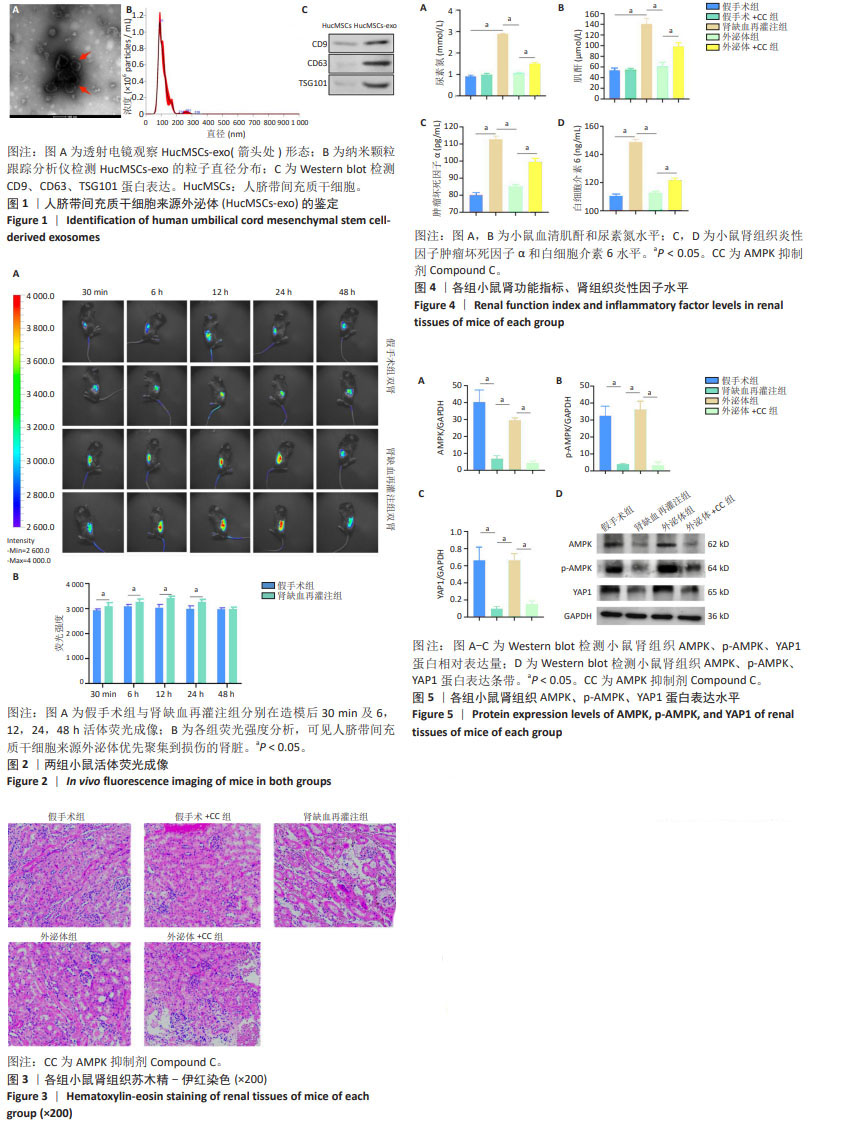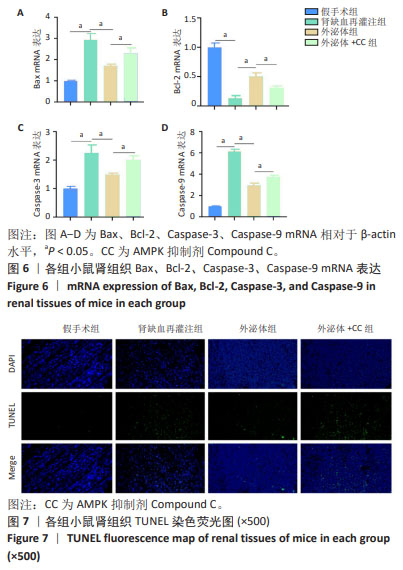[1] BAGHERI A, RADMAN G, ARIA N, et al. The Effects of Quercetin on Apoptosis and Antioxidant Activity in a Renal Ischemia/Reperfusion Injury Animal Model. Drug Res (Stuttg). 2023;73(5):255-262.
[2] CHEN J, ZHENG QY, WANG LM, et al. Proteomics reveals defective peroxisomal fatty acid oxidation during the progression of acute kidney injury and repair. Heliyon. 2023;9(7):e18134.
[3] TAMMARO A, KERS J, SCANTLEBERY AML, et al. Metabolic Flexibility and Innate Immunity in Renal Ischemia Reperfusion Injury: The Fine Balance Between Adaptive Repair and Tissue Degeneration. Front Immunol. 2020;11:1346.
[4] NØRGÅRD MØ, SVENNINGSEN P. Acute Kidney Injury by Ischemia/Reperfusion and Extracellular Vesicles. Int J Mol Sci. 2023;24(20):15312.
[5] 贾圣琪,罗文龙,田丁元,等.急性肾缺血再灌注损伤模型小鼠线粒体去乙酰化酶3的表达[J].中国组织工程研究,2023,27(8):1172-1178.
[6] STEINBERG GR, HARDIE DG. New insights into activation and function of the AMPK. Nat Rev Mol Cell Biol. 2023;24(4):255-272.
[7] CAI J, CHEN X, LIU X, et al. AMPK: The key to ischemia-reperfusion injury. J Cell Physiol. 2022;237(11):4079-4096.
[8] CAO S, XIAO H, LI X, et al. AMPK-PINK1/Parkin mediated mitophagy is necessary for alleviating oxidative stress-induced intestinal epithelial barrier damage and mitochondrial energy metabolism dysfunction in IPEC-J2. Antioxidants . 2021;10(12):2010.
[9] NOORBAKHSH N, HAYATMOGHADAM B, JAMALI M, et al. The Hippo signaling pathway in leukemia: function, interaction, and carcinogenesis. Cancer Cell Int. 2021;21(1):705.
[10] BAILLY C. Pharmacological Properties and Molecular Targets of Alisol Triterpenoids from Alismatis Rhizoma. Biomedicines. 2022;10(8):1945.
[11] FENG J, LI H, ZHANG Y, et al. Mammalian STE20-Like Kinase 1 Deletion Alleviates Renal Ischaemia-Reperfusion Injury via Modulating Mitophagy and the AMPK-YAP Signalling Pathway. Cell Physiol Biochem. 2018;51(5):2359-2376.
[12] WANG J, CHEN Z, SUN M, et al. Characterization and therapeutic applications of mesenchymal stem cells for regenerative medicine. Tissue Cell. 2020;64:101330.
[13] BLONDEEL J, GILBO N, DE BONDT S, et al. Stem cell Derived Extracellular Vesicles to Alleviate ischemia-reperfusion Injury of Transplantable Organs. A Systematic Review. Stem Cell Rev Rep. 2023;19(7):2225-2250.
[14] 袁圆,郭文文,王浩,等.人脐带间充质干细胞来源外泌体通过调控SLC7A11/GPX4通路缓解大鼠肾缺血再灌注损伤[J].陆军军医大学学报,2023, 45(11):1173-1180.
[15] 郭文文,袁圆,王浩,等.人脐带间充质干细胞来源外泌体在肾缺血一再灌注损伤中的保护作用及其机制研究[J].器官移植,2023,14(3):371-378.
[16] CAO JY, WANG B, TANG TT,et al. Exosomal miR-125b-5p deriving from mesenchymal stem cells promotes tubular repair by suppression of p53 in ischemic acute kidney injury. Theranostics. 2021;11(11):5248-5266.
[17] ZHANG Y, WANG C, BAI Z, et al. Umbilical Cord Mesenchymal Stem Cell Exosomes Alleviate the Progression of Kidney Failure by Modulating Inflammatory Responses and Oxidative Stress in an Ischemia-Reperfusion Mice Model. J Biomed Nanotechnol. 2021;17(9):1874-1881.
[18] DING C, ZHENG J, WANG B, et al. Exosomal MicroRNA-374b-5p From Tubular Epithelial Cells Promoted M1 Macrophages Activation and Worsened Renal Ischemia/Reperfusion Injury. Front Cell Dev Biol. 2020;8:587693.
[19] ZHANG Y, WANG J, YANG B, et al. Transfer of MicroRNA-216a-5p From Exosomes Secreted by Human Urine-Derived Stem Cells Reduces Renal Ischemia/Reperfusion Injury. Front Cell Dev Biol. 2020;8:610587.
[20] PARK M, KWON CH, HA HK, et al. RNA-Seq identifies condition-specific biological signatures of ischemia-reperfusion injury in the human kidney. BMC Nephrol. 2020;21(Suppl 1):398.
[21] CHEN Y, XIONG Y, LUO J, et al. Aldehyde Dehydrogenase 2 Protects the Kidney from Ischemia-Reperfusion Injury by Suppressing the IκBα/NF-κB/IL-17C Pathway. Oxid Med Cell Longev. 2023;2023:2264030.
[22] ZHU M, HE J, XU Y, et al. AMPK activation coupling SENP1-Sirt3 axis protects against acute kidney injury. Mol Ther. 2023;31(10):3052-3066.
[23] SHAUGHNESSEY EM, KANN SH, CHAREST JL, et al. Human Kidney Proximal Tubule-Microvascular Model Facilitates High-Throughput Analyses of Structural and Functional Effects of Ischemia-Reperfusion Injury. Adv Biol (Weinh). 2024; 8(1):e2300127.
[24] WANG W, ZHANG M, REN X, et al. Single-cell dissection of cellular and molecular features underlying mesenchymal stem cell therapy in ischemic acute kidney injury. Mol Ther. 2023;31(10):3067-3083.
[25] KALLURI R, LEBLEU VS. The biology, function, and biomedical applications of exosomes. Science. 2020;367(6478):eaau6977.
[26] MISSOUM A. Recent Updates on Mesenchymal Stem Cell Based Therapy for Acute Renal Failure. Curr Urol. 2020;13(4):189-199.
[27] WANG ZG, HE ZY, LIANG S, et al. Comprehensive proteomic analysis of exosomes derived from human bone marrow, adipose tissue, and umbilical cord mesenchymal stem cells. Stem Cell Res Ther. 2020;11(1):511.
[28] YAN Y, MA Z, ZHU J, et al. miR-214 represses mitofusin-2 to promote renal tubular apoptosis in ischemic acute kidney injury. Am J Physiol Renal Physiol. 2020;318(4):F878-F887.
[29] YANG BC, KUANG MJ, KANG JY, et al. Human umbilical cord mesenchymal stem cell-derived exosomes act via the miR-1263/Mob1/Hippo signaling pathway to prevent apoptosis in disuse osteoporosis. Biochem Biophys Res Commun. 2020;524(4):883-889.
[30] 张曾宇,陈嘉敏,卢圣花,等.苷类中药单体减轻心肌缺血再灌注损伤机制的研究进展[J].实用心脑肺血管病杂志,2023,31(9):115-121.
[31] 陈蕾,王雪如,黄杰,等. AMPK介导线粒体融合与裂变在丁苯酞抗小鼠脑缺血/再灌注损伤中的作用[J].中国新药杂志,2022,31(19):1929-1935.
[32] ZHOU Q, HE X, ZHAO X, et al. Ginsenoside Rg1 Ameliorates Acute Renal Ischemia/Reperfusion Injury via Upregulating AMPKα1 Expression. Oxid Med Cell Longev. 2022;2022:3737137.
[33] HABSHI T, SHELKE V, KALE A,et al. Gaikwad AB. Hippo signaling in acute kidney injury to chronic kidney disease transition: Current understandings and future targets. Drug Discov Today. 2023 ;28(8):103649.
[34] ZEYBEK ND, BAYSAL E, BOZDEMIR O, et al. Hippo Signaling: A Stress Response Pathway in Stem Cells. Curr Stem Cell Res Ther. 2021;16(7):824-839.
[35] KOO JH, GUAN KL. Interplay between YAP/TAZ and Metabolism. Cell Metab. 2018;28(2):196-206.
[36] XING J, WANG Z, XU H, et al. Pak2 inhibition promotes resveratrol-mediated glioblastoma A172 cell apoptosis via modulating the AMPK-YAP signaling pathway. J Cell Physiol. 2020;235(10):6563-6573.
[37] BAE SJ, BAK SB, KIM YW. Coordination of AMPK and YAP by Spatholobi Caulis and Procyanidin B2 Provides Antioxidant Effects In Vitro and In Vivo. Int J Mol Sci. 2022;23(22):13730.
[38] GRANGE C, TAPPARO M, BRUNO S, et al. Biodistribution of mesenchymal stem cell-derived extracellular vesicles in a model of acute kidney injury monitored by optical imaging. Int J Mol Med. 2014;33(5):1055-1063.
[39] TETTA C, DEREGIBUS MC, CAMUSSI G. Stem cells and stem cell-derived extracellular vesicles in acute and chronic kidney diseases: mechanisms of repair. Ann Transl Med. 2020;8(8):570. |

